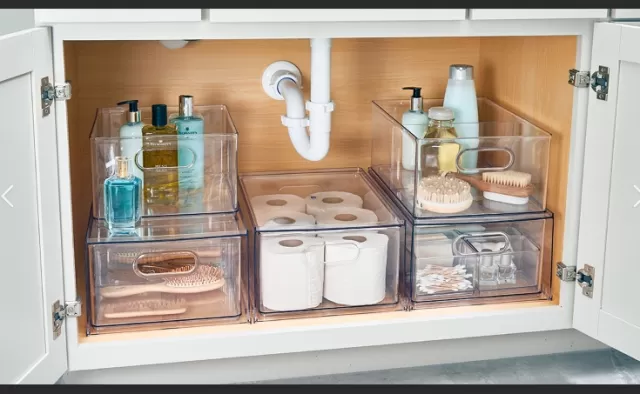Bathroom Storage No-Nos: Keep Towels to Makeup Elsewhere. While bathrooms offer valuable storage space, it’s crucial to be mindful of the high moisture levels, humidity, and temperature fluctuations that characterize these spaces. The unique environment created by showers and baths can make certain items vulnerable to mildew and bacteria, potentially compromising their integrity and safety. To maintain a sanitary and functional bathroom.
Preserving the Brilliance: Tips to Care for Your Jewelry

To ensure the lasting beauty of your jewelry, it’s crucial to adopt proper care practices, especially when it comes to metals and gemstones.
Here are some tips to help you preserve the brilliance of your cherished pieces:.
Avoid Heat and Moisture: Excessive heat and moisture can contribute to tarnishing of certain metals and may harm gemstones or delicate materials.
Remove your jewelry before activities involving water, such as swimming or showering, and store them in a cool, dry place.
Mind Personal Care Products: Jewelry can come into contact with various personal care products in the bathroom, such as lotions, perfumes, or cleaning agents.
Some chemicals in these products may react with the metals or stones in the jewelry, leading to discoloration or damage. Put on your jewelry after applying these products to minimize contact.
Regular Cleaning: Clean your jewelry regularly to remove dirt, oils, and residues that can accumulate over time.
Use a soft brush, mild soap, and warm water for cleaning. Be gentle, especially with more delicate pieces.
Storage Matters: Store your jewelry in a dedicated jewelry box or pouch to prevent scratches and tangles.
Consider keeping different pieces separate to avoid potential damage from contact with other jewelry.
Professional Inspection: Schedule regular professional inspections for your valuable pieces.
Jewelers can check for loose stones, worn prongs, or other issues that might lead to more significant problems if left unattended.
Special Care for Gemstones: Different gemstones have specific care requirements.
Be aware of the characteristics of each stone in your jewelry and follow guidelines for their care. For example, pearls are particularly sensitive and should be handled with care.
Remove Before Activities: Before engaging in activities that may put stress on your jewelry, such as exercising or participating in sports, consider removing your pieces to prevent damage.
By incorporating these care practices into your routine, you can enjoy your jewelry for years to come, preserving its brilliance and sentimental value.
Maintaining Freshness: Tips for Towel Care
To keep your towels fresh and in optimal condition, consider incorporating the following tips into your routine:.
Adequate Drying: After using towels, ensure they are thoroughly dried before storing them.
Hanging them on towel racks or hooks with proper ventilation allows air to circulate, preventing the growth of mold and mildew.
Regular Washing: Even if towels appear clean, they can harbor bacteria and odors.
Wash your towels regularly, following care instructions on the labels. Using hot water and a quality detergent can help eliminate bacteria and odors.
Proper Storage: If possible, store towels in a dry and well-ventilated area.
Avoid leaving damp towels in the bathroom, as prolonged exposure to moisture can lead to a musty smell. Consider using a nearby closet for storage.
Rotate Towels: If you have a collection of towels, rotate their use to allow each one sufficient time to dry between uses.
This practice helps prevent the buildup of moisture and extends the freshness of your towels.
Avoid Overcrowding: Avoid overcrowding towels in storage spaces, as this can limit airflow and contribute to mustiness.
Arrange them loosely to promote air circulation.
Use Linen Sachets: Place linen sachets or potpourri in your towel storage area to impart a pleasant fragrance and discourage musty odors.
Sunlight Exposure: On sunny days, consider hanging your towels outdoors to benefit from the natural disinfecting and freshening properties of sunlight.
Regular Deep Cleaning: Periodically, deep clean your towels to remove any lingering odors or residue.
This can be done by adding white vinegar or baking soda to the wash cycle or using a specialty laundry cleaner.
By adopting these practices, you can ensure that your towels remain fresh, soft, and pleasant to use.
Regular cleaning and proper storage go a long way in preserving the quality of your towels and enhancing your overall bathing experience.
Preserving Paper Products: Tips for Bathroom Storage

To maintain the quality and cleanliness of backup paper products in your bathroom, consider the following storage tips:.
Choose a Dry Storage Location: Select a storage space in your bathroom that is dry and well-ventilated.
Avoid areas where paper products might be exposed to humidity or extreme temperature fluctuations.
Use Sealed Containers: Consider storing backup paper products in sealed containers or plastic bins to protect them from aerosol particles and potential contamination.
This adds an extra layer of defense against environmental factors.
Elevate Storage: Keep backup paper products elevated, especially if your bathroom is prone to spills or splashes.
Placing them on a shelf or in a cabinet can help prevent direct contact with the bathroom floor and minimize exposure to cleaning products.
Avoid Direct Sunlight: Direct sunlight can contribute to the degradation of paper products over time.
Store backups away from windows or other areas where they might be exposed to prolonged sunlight.
Rotate Stock: If you have multiple packages of backup paper products, consider rotating your stock.
Use older items first to ensure freshness and prevent any long-term storage issues.
Keep Products Sealed: If backup paper products are packaged in plastic or sealed wrappers, keep them sealed until you’re ready to use them.
This helps maintain their cleanliness and prevents exposure to airborne particles.
Regularly Check Expiry Dates: Some paper products, such as facial tissues or wet wipes, may have expiration dates.
Check these dates periodically to ensure you’re using them within their recommended timeframe.
Monitor Product Quality: Periodically check the quality of your backup paper products.
If you notice any signs of damage, such as discoloration or an unusual odor, it may be time to replace them.
By implementing these storage practices, you can extend the lifespan and quality of your backup paper products in the bathroom, ensuring that they remain clean, dry, and ready for use when needed.
.
.
.
.
.
.
Preserving Precious Memories: Why Photographs Should Stay Out of the Bathroom
Photographs capture cherished moments and memories, and their preservation requires thoughtful care.
Here’s why it’s advisable to avoid keeping photographs in the bathroom:.
Moisture and Emulsion: Bathrooms are inherently humid environments, and excessive moisture can be detrimental to photographs.
The emulsion layer on the front of a photo can absorb this moisture, leading to potential damage. In particular, if a framed photo is exposed to high humidity, the emulsion may adhere to the glass, making it difficult or impossible to remove without causing irreversible harm.
Adhesion to Glass: The combination of moisture and temperature fluctuations in the bathroom can contribute to the emulsion of a photograph adhering to the glass surface of a frame.
Once this adhesion occurs, attempting to separate the photo from the glass may result in tearing or damage to the image.
Long-Term Impact: The effects of moisture on photographs are often gradual and may not be immediately apparent.
Over time, however, prolonged exposure to humidity can lead to fading, discoloration, or the deterioration of the photograph itself.
To safeguard your precious memories, it’s advisable to display photographs in areas of your home that offer stable humidity levels and minimal temperature fluctuations.
Here are alternative suggestions:.
Living Room or Bedroom: Display photographs in common living spaces or bedrooms where humidity is typically lower, and temperature conditions are more stable.
Frames with Protective Seals: Choose frames with protective seals or backings that help minimize the entry of moisture.
Avoid Direct Sunlight: Protect photographs from direct sunlight, as prolonged exposure can lead to fading and damage.
Consider using UV-protective glass for framed photos.
Regular Inspection: Periodically inspect your framed photographs for any signs of damage, especially if they are displayed in areas with fluctuating conditions.
By mindful placement and regular inspection, you can ensure that your photographs remain in excellent condition, preserving the beauty and sentimental value of these cherished memories.
Preserving Your Polish: Why Nail Polish Doesn\’t Belong in the Bathroom

Nail polish is a beauty essential that requires proper care to maintain its consistency and quality.
Here’s why it’s advisable to keep nail polish out of the bathroom:.
Temperature Fluctuations: Bathrooms are susceptible to temperature changes, especially if they are not well-insulated.
Fluctuations in temperature, whether due to hot showers, cold nights, or other environmental factors, can have a significant impact on the consistency of nail polish.
Formulation Changes: Extreme temperatures, whether hot or cold, can lead to changes in the formulation of nail polish.
When exposed to heat, the polish may become thinner, making it challenging to apply evenly. On the other hand, cold temperatures can cause the polish to thicken or become clumpy, affecting its smooth application.
Moisture Exposure: Bathrooms are inherently humid spaces, and excess moisture in the air can contribute to the deterioration of nail polish.
Humidity can lead to the separation of ingredients in the polish, resulting in an uneven texture and compromised quality.
To ensure the longevity and optimal performance of your nail polish, consider the following storage tips:.
Cool, Dry Storage: Store your nail polish in a cool, dry place away from direct sunlight.
A bedroom or vanity area with more stable temperatures is preferable.
Avoid Extreme Temperatures: Keep nail polish away from areas with extreme temperatures, such as windowsills, bathrooms, or cars.
Exposure to heat or cold can adversely affect the formulation.
Tighten Lids Securely: Ensure that the lids of your nail polish bottles are tightly secured after each use to prevent air exposure, which can contribute to drying and thickening.
Shake Before Use: Before applying nail polish, gently shake the bottle to ensure that the ingredients are well-mixed.
This helps maintain the proper consistency for a smoother application.
By adhering to these storage practices, you can extend the life of your nail polish, ensuring that it remains in excellent condition and ready for a flawless manicure.
*The information is for reference only.